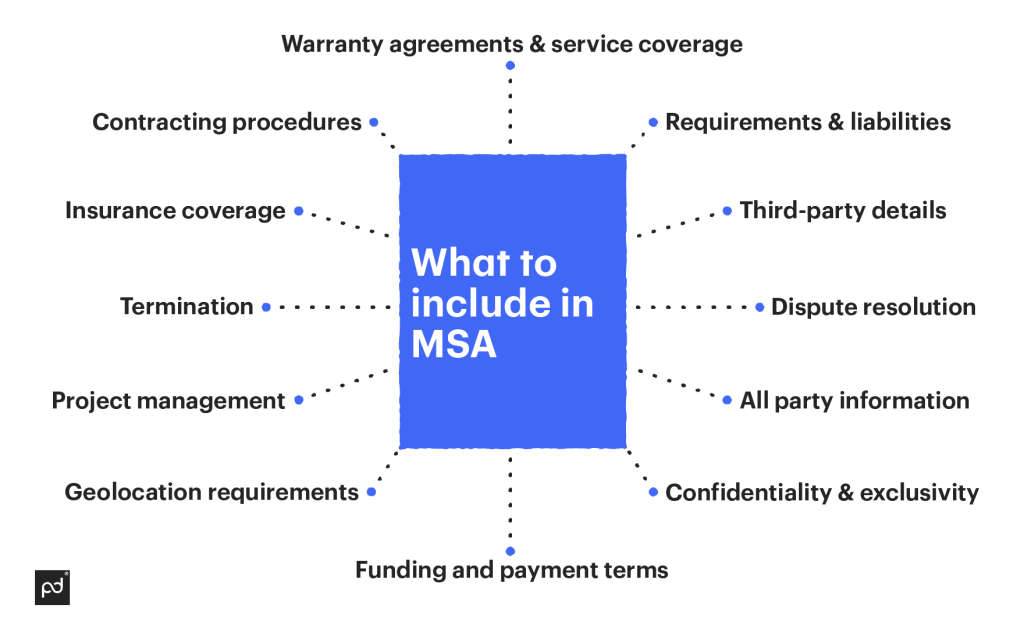Most modern business relationships are built on contracts.
Whether a company needs goods or provides services, contractual obligations ensure that everyone is on the same page when it’s time to get to work.
Unfortunately, many contracts are limited in scope, and it can take time to negotiate new agreements and remove production roadblocks.
But what if your company could set up a framework with trusted partners that expedites the rest of the contracting process?
You’d be able to place orders, request services, and streamline productivity workflows with ease.
All of that is possible with a master service agreement.
Here’s what you need to know.
What is a master service agreement?
In business, a master service agreement — also called an MSA or a framework agreement — is a governing contract set up between two signing parties.
Typically, MSAs are designed to create a set of agreed-upon terms that apply to all other contracts between the parties, like statements of work or service level agreements.
Rather than relying on SOWs and SLAs to carry their own terms, the MSA acts as an operational rulebook that applies to all subsequent agreements and lower-tier contracts.

Master Service Agreement
Used 5119 times
Reviewed by Sharita Jennings
Between the service and the client, this Master Service Agreement governs work orders. The Parties concur that Client may order services by signing a Work Order, which will be governed by the conditions of this Agreement.
Use this templateHere’s an example of a master service agreement in action:
Company A and Company B have negotiated a master service agreement that includes, among other things, limits to employee work schedules and hours.
After negotiating and signing the MSA, Company A issues a separate service contract to Company B for technical support related to their IT systems.
The service agreement includes no mention of or exception to the employee work schedules defined as part of the MSA.
If Company B accepts the contract, its employees would need to be available to act as tech support for Company A during the work schedules defined by their MSA even though the service agreement did not specifically designate working hours.
Master service agreements create a starting point for two partnering companies. If no exceptions are made, the language of the MSA applies automatically.
This allows a single MSA to govern the terms and conditions of multiple contracts and streamlines the creation of future contracts between organizations and their service providers.
Advantages of a master service agreement
As you might expect, there are several major advantages to setting up MSAs, including the ability to expedite contract workflows, save money, and increase productivity.
Here are the key benefits of using MSAs to structure future agreements:
1. Faster setup
MSAs set up a framework for a long-term relationship between two companies. Once they are set up, contracts and agreements governed by the MSA will be shorter and take far less time to create.
2. Customizable
No two MSAs are the same. Like other contracts, MSAs can be customized to fit your business needs.
You can include language that applies to every subsequent contract, such as intellectual property clauses, indemnification agreements, or confidentiality agreements.
3. Reduces labor costs
Workers are busy.
In fact, 24% of workers say that data input is their biggest time suck at work. By using MSAs, you can drastically reduce the amount of input required to set up a contract.
4. Consistency
Using MSA agreements will help to create a more consistent working environment between the two companies.
Unless otherwise stated, every new contract contains the same set of terms and working guidelines.
5. Better terms
Because an MSA contract is designed to strengthen long-term relationships, creating one gives both companies and opportunities to fight for better terms during the negotiation process.
6. Focused contracts
An MSA creates a basic framework for all future transactions.
This allows you to separate statements of work, service level agreements, and similar types of agreements away from the primary contract (the MSA) while still enjoying the pre-established terms.
7. Faster renewals
Over 50% of top-performing companies renew contracts annually, and this is even easier with an MSA.

Since MSAs are typically good for years, renewing all subordinate contracts becomes much faster and easier to accomplish.
The ability to create a single, master document that governs key aspects of your business relationship can be a major incentive for long-term business partners.
Done correctly, a legal MSA can establish work standards and contracting workflows that are simple to understand and profitable for both signing parties.
Disadvantages of a master service agreement
While MSAs come with a tremendous amount of benefits, it can take some time to achieve those positive outcomes.
Here are the downsides to using MSAs, and you should consider them carefully before you try to create one.
1. Elongated creation time
Because MSAs tend to cover so many essential details of a business relationship, they can take a very long time to create.
Often, creating MSAs takes so long that other contracts between partnering companies are issued and fulfilled while the MSA is actually negotiated.
Though you can speed up this process with the right negotiation tools, you should be prepared for a longer process when you decide to create the MSA.
2. Highly complex
While MSAs can reduce the legalese around subsequent contracts, the MSA itself can quickly become very complicated if the creation process isn’t properly managed.
Because parties are trying to create terms that will serve over a long period of time, MSAs can become a catchall document.
This can lead to inconsistencies in the agreement as parties try to cover every possible outcome.
3. Inflexible if improperly created
It’s possible for MSAs to become so rigid that they become too difficult for either company to use.
This happens when the terms of the MSA are so strict that the subsequent contracts no longer meet the requirements for one (or both) parties.
MSAs need to establish a framework while remaining flexible enough to be useful, and it’s possible to cross that line without realizing it until it’s too late.
4. It may require different partners
If you want to create an MSA with a small business or company subsidiary, you may not be able to do so directly.
Often, parent companies (and their law firms) will want to be involved in structuring MSAs.
If you haven’t worked with these individuals before, the resulting MSA might be awkward or untenable.
It’s worth noting that, while there are some key disadvantages to MSAs, the payoff can be worth it.
You should know before starting this contract negotiation that MSAs tend to be marathon events rather than short-term sprints.
MSA checklist: What to include in a master service agreement

Because MSAs serve as a framework for all future contracts, it makes the most sense to put any and most contracting details inside the MSA.
Keep in mind that if certain passages don’t make it into your MSA, those terms will need to be negotiated on a per-contract basis.
If you don’t expect the terms to change, pushing to include them in the MSA is usually the best course of action.
Here’s a brief checklist of items that you might consider including in your MSA.
- All party information. Includes business names, addresses, relevant account information, and more. This establishes the signing parties in the relationship and places all relevant business details in one place.
- Confidentiality and exclusivity. Covers any confidential information that must be disclosed for parties to operate. Might include non-disclosure agreements, outline intellectual property rights, and more.
- Contracting procedures. Covers how contracts are created, issued, and assigned from one company to another. May include multiple steps.
- Dispute resolution. Details what companies should do in the event of a dispute. May include arbitration clauses, indemnity agreements, limitations of liability, who pays attorney fees for legal services, and more.
- Funding and payment terms. Outlines how companies want to be paid for future transactions. It could include the use of escrow services, recurring payment deadlines, or the formation of regular payment schedules.
- Geolocation requirements. May include mandatory geographic locations for workers or manufacturing, such as mandating that all employees are located in a single country or that proprietary company information is only accessible from a specific location or device.
- Insurance coverage. Outlines who is responsible for paying for insurance and/or what must be covered by insurance (property damage, liability insurance, etc.)
- Project management. Determines how projects should be managed, who should manage them, and what necessary steps must be undertaken during the project management process.
- Requirements & liabilities. Outlines any mandatory actions that must be taken by either party as part of the MSA or a related project. This could include purchasing and maintaining real estate, enforcing background checks on employees, or determining the appropriate risk allocation.
- Termination. Covers what should be done if either party wishes to terminate the MSA or any contract that falls under the MSA framework.
- Third-party details. Might include details about working with third-party vendors or subcontractors, what steps need to be involved, pricing minimums or working conditions for subcontractors, and similar requirements.
- Warranty agreements and service coverage. Outlines any coverage agreements included as part of the MSA itself. If the MSA dictates that overarching services must be applied to the business relationship (Company B supplies tech support for all products created by contracts under the MSA and subsequent agreements), these sections outline those and similar details.
Don’t forget that MSAs are entirely negotiable and can be tailored to your needs and preferences.
You may not want to include every item in our checklist, or you might want to add items that we haven’t listed here.
As you start to create your MSA, work closely with your business partner to determine what points need to be included in your master document.
Differentiating MSAs and other documents
Because the purpose of a master service agreement is to act as a framework agreement for other documents, an MSA is different from other types of business contracts that you might see.
In this section, we’ll take a closer look at how MSAs compare to common business contracts.
Master service agreement vs a service level agreement
A service-level agreement is a contract for specific services provided from one company to another.
This contract typically outlines the level of service you expect to receive from a vendor and mandates service minimums that the vendor is expected to maintain.
SLAs commonly cover issues surrounding service availability, defect rates, technical quality, security, results, and other quantifiable metrics.
Master service agreements are framework agreements that sit on top of SLAs and similar contracts.
SLAs can be governed by the clauses set forth in the MSA, but an SLA can also have its own set of metrics and penalties in addition to what is mandated by the MSA.
Master service agreement vs a statement of work
Statements of work are typically used for one-off or specific workloads that need to be accomplished.
While they aren’t set up exclusively as short-term projects, the milestones are clearly defined and both parties have an understanding of the project scope.
Unless otherwise negotiated, master service agreements govern most or all of the content in a standard SOW aside from the work itself.
Because every SOW will have its own workloads and deadline requirements, MSAs won’t have that specific information.
However, the MSA will likely have a clause for the majority of terms used to create a standard SOW.
Like SLAs and other documents subordinate to MSAs, a statement of work can have its own set of metrics, deliverables, and penalties while still falling under the umbrella of the master service agreement.
When using MSAs, SOWs and similar documentation can be shorter and more direct, since the basic requirements have already been set forth as part of the MSA.
Master service agreement vs a contract
At its core, a master service agreement is a high-level contract that governs other contracts.
Once the MSA is established, most other contracts between the company will fall under the guidelines established by the MSA.
Even so, most contracts (including the MSA) will need to be treated as separate documents and managed appropriately, so be prepared to treat an MSA like most other documentation when it comes to contract management.
Tips for creating better master service agreements
Creating the perfect master service agreement can be a tricky and convoluted process.
The process becomes more manageable if you go in with the right mindset and a clear understanding of what you should accomplish.
Here are a few tips to help you when creating a master service agreement.
1. Don’t rush things
MSAs take time to set up and are often negotiated over weeks or months.
Take the time to structure a deal that is beneficial for both parties and that contributes to a long-term, stable partnership.
2. Set up a space for contract negotiations
Right now, only about 59% of companies have a good negotiation platform in place.
Before getting started, set up a space where contract review, negotiation, and collaboration can take place.
Document creation platforms like PandaDoc are great for this because they allow for real-time collaboration on key documents.
3. Limit the scope of the MSA
It’s tempting to create an MSA that fits every contract. The truth is that the more contingencies you negotiate for, the more convoluted the MSA will become.
If you find that neither party can come to a final agreement or that the contract language won’t be flexible enough to suit your needs, don’t be afraid to omit those clauses from the MSA and include them on SOWs and SLAs.
4. Don’t use an MSA template
PandaDoc offers over 700 templates in our template library, but an MSA isn’t one of them.
Why? Because MSAs are unique to the partnership between two distinct businesses.
Ultimately, it will be up to you to decide what you should include, and a template can be a poor starting point for such an open-ended negotiation.
5. Choose your MSA partnerships carefully
Most MSAs are structured between long-term partners who plan on doing business together for the foreseeable future.
Structuring an MSA with new business entities or with vendors you don’t know well could be pointless, especially considering the amount of time it takes to create the contract.
We’ve said it before, but it’s worth mentioning again: No two MSAs are alike.
Before you bring up the possibility of an MSA with vendors and partners, be sure that it’s a good fit for your needs and that you have the resources and the relationship to successfully create one.
Build better MSAs with PandaDoc
Want to build a better master service agreement and strengthen your business partnership at the same time?
PandaDoc can help. Our platform is equipped with all the tools you need to successfully structure your business contracts, quotes, sales proposals, and more.
With collaborative editing, redlining, versioning, and a selection of other great tools, PandaDoc has everything you need to quickly and easily create MSAs and other complex documents.
Sign up for a free 14-day trial and see how PandaDoc can streamline your entire document workflow.
Disclaimer
PandaDoc is no PandaDoc is not a law firm, or a substitute for an attorney or law firm. This page is not intended to and does not provide legal advice. Should you have legal questions on the validity of e-signatures or digital signatures and the enforceability thereof, please consult with an attorney or law firm. Use of PandaDocs services are governed by our Terms of Use and Privacy Policy.


